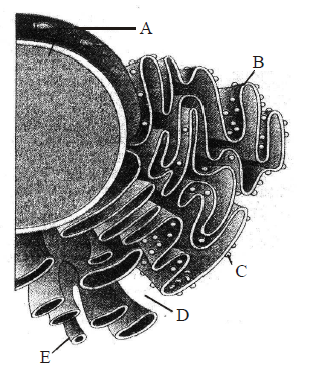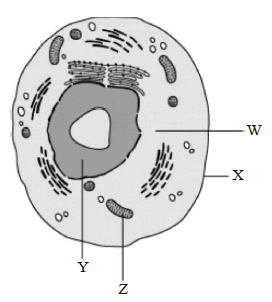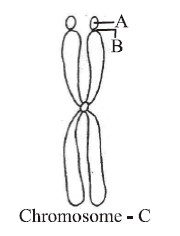Which of the following statements is/are correct ?
- The shape of the cells may vary with the function they perform.
- Human RBC is about 7.0 ??m in diameter.
- Cytoplasm is the main area of cellular activities.
- Various chemical reactions occur in cytoplasm to keep the cell in the living state.
(i), (ii), (iii) and (iv)
Only (i) and (ii)
Only (iv)
None of the above
Correct Answer :
A. (i), (ii), (iii) and (iv)
All the statements are correct.
Related Questions
Choose the incorrect match.
Nucleus RNA
Lysosome Protein synthesis
Mitochondria Respiration
Cytoskeleton Microtubules
The figure below shows the structure of a mitochondrion with its four parts labelled (A), (B), (C) and (D).

Select the part correctly matched with its function.
Part (D): Outer membrane Gives rise to inner membrane by splitting.
Part (B): Inner membrane Forms infoldings called cristae.
Part (C): Cristae Possess single circular DNA molecule and ribosomes.
Part (A): Matrix Major site for respiratory chain enzymes.
Study the following statements on cilium or flagellum and answer the question.
- Cilium / Flagellum contains an outer ring of nine doublet microtubules surrounding two singlet microtubules.
- Cilia are smaller which work like oars, causing the movement of either the cells or surrounding fluid.
- Flagella are comparatively longer and responsible for cell movement.
- Cilium and flagellum are covered with plasma membrane.
Which of the above statements are correct?
(i) and (ii)
(i), (ii), (iii) and (iv)
(i) and (iv)
(ii) and (iii)
Identify the components labelled as A, B, C, D and E in the diagram given below from the list (i) to (viii).

- Cristae of mitochondria
- Inner membrane of mitochondria
- Cytoplasm
- Smooth endoplasmic reticulum
- Rough endoplasmic reticulum
- Mitochondrial matrix
- Ribosome
- Nucleus
A - (viii), B - (v), C - (vii), D - (iii), E - (iv)
A - (i), B - (iv), C - (vii), D - (vi), E - (iii)
A - (vi), B - (v), C - (iv), D - (vii), E - (i)
A - (v), B - (i), C - (iii), D - (ii), E - (iv)
Which of the following statements are correct?
Na+/K+ pump is an example of active transport.
In plant cells lipid like steroidal hormones are synthesized in SER.
In plant cells, the vacuoles can occupy up to 10% of the volume of the cell.
Chlorophyll and leucoplast are responsible for trapping light energy essential for photosynthesis.
Which of the following cell organelles were discovered after the introduction of electron microscope?
Mitochondria
Endoplasmic reticulum
Ribosomes
Both (b) and (c)
The main organelle involved in modification and routing of newly synthesized proteins to their destinations is
chloroplast
mitochondria
lysosome
endoplasmic reticulum
Select the correct match of the types of neuron present in column I with its location given in column II.
| Column I | Column II |
|---|---|
| A. Centrioles | (i) Non-membrane bound organelle which helps in cell division |
| B. Fimbriae | (ii) Special structure of bacteria which help them to attach with rocks in stream and also to host tissue |
| C. Endomembrane | (iii) Includes those organelles system whose functions are coordinated |
| D. Mitochondria | (iv) Divide by fission and site of aerobic respiration |
A - (i), B - (ii), C - (iii), D - (iv)
A - (iii), B - (i), C - (ii), D - (iv)
A - (iii), B - (i), C - (iv), D - (ii)
A - (i), B - (iv), C - (iii), D - (ii)
The lipid component of the membrane mainly consists of __________.
polysaccharides
phosphoglyceride
monosaccharaides
both (a) and (c)
Function of RER is
autolysis
protein synthesis
lipid synthesis
carbohydrate synthesis
Which of the following pair are correctly matched.
A. Microtubules Structural components of cilia
B. Centrioles Store hydrolytic enzymes
C. Amyloplasts Store oil protein and starch in plants
A, B and C
A and B
A
A and C
Axoneme with 9 + 2 microtubular arrangement occurs in
cilia
flagella
both (a) and (b)
centriole
Cell sap is a
living content of cytoplasm.
nonliving content of cytoplasm.
nonliving content of vacuole.
living content of vacuole.
9.A student was given cell samples (A and B) to identify parts which are highlighted. He observed the samples under the microscope and list down the function of the part of cell sample. The information collected by the student is listed in the table below, on the basis of which the student infers that the samples contain the organelles.
| Sample A | Sample B |
|---|---|
| Make energy available for cellular metabolism | Generates ATP and synthes izes s ugar |
| Absent in cell that carry oxygen throughout the body | Present in plant cell |
| Called the energy currency of cell | Source o f all the food energy |
Explain why the samples were belonged to eukaryotic cell and not prokaryotic cell? Because,
eukaryotic cell have membrane bound organelles.
eukaryotic cell have non - membrane bound organelles.
eukaryotic cell are smaller and multiply more rapidly than prokaryotic cells.
eukaryotic cell are larger and multiply more rapidly than prokaryotic cells.
The best way to identify a cell as either prokaryotic or eukaryotic is to determine whether
it came from a single-celled or multicellular organism.
it has a nucleus.
it has a plasma membrane.
it has cytosol.

Which function is carried out by the cell organelle 'X'?
helps control the movement of substance in and out of the cell
passes information from the parent cell to newly formed cell
maintains the proper shape of the cell and serves as a protective barrier
helps the cell to make food with the help of chlorophyll and sunlight
You are asked to examine a cell using a powerful light microscope. The image you see has a clearly defined nucleus and mitochondria. It also has a large central vacuole and chloroplasts. From what group of organisms did this cell most likely come?
Bacteria
Protists
Fungi
Plants
Match column-I with column-II and select the correct option.
| Column - I | Column - II |
|---|---|
| A. Golgi apparatus | I. Storage |
| B. Mitochondria | II. Photosynthesis |
| C. Vacuoles | III. Transport |
| D. Grana | IV. Secretion |
| .. | V. Respiration |
A - IV, B - V, C - I, D - II
A - I, B - II, C - IV, D - III
A - IV, B - I, C - II, D - III
A - I, B - II, C - III, D - IV
The fluidity of membranes in a plant in cold weather may be maintained by
increasing the number of phospholipids with unsaturated hydrocarbon tails.
increasing the proportion of integral proteins.
increasing concentration of cholesterol in membrane.
increasing the number of phospholipids with saturated hydrocarbon tail.
Active transport differs from passive transport in that active transport
requires energy.
always requires input of ATP.
moves molecules against a concentration gradient.
both (a) and (c)
Which of the following statements is/are correct ?
- The shape of the cells may vary with the function they perform.
- Human RBC is about 7.0 ??m in diameter.
- Cytoplasm is the main area of cellular activities.
- Various chemical reactions occur in cytoplasm to keep the cell in the living state.
(i), (ii), (iii) and (iv)
Only (i) and (ii)
Only (iv)
None of the above
What would happen if lysosomes get ruptured in a cell?
Cell dies
Cell shrinks
Cell swell up
Nothing would happen
Polysome is a chain of
oxysomes
sphaerosomes
ribosomes
dictyosomes
Microtubules are absent in
mitochondria
centriole
flagella
spindle fibres
In which method of transport, plasma membrane does not require carrier molecule?
Active transport
Facilitated diffusion
Simple diffusion
Na+ K+ pump
Read the statements given below with regard to the functions performed by Golgi apparatus ?
- Transport and chemically modify the materials contained within it.
- Performs the function of packaging materials.
- Important site of formation of glycoproteins and glycolipids.
Which of the following is the correct answer ?
(i) is wrong but (ii) and (iii) are correct
(ii) is wrong but (i) and (iii) are correct
(ii) and (iii) are wrong but (i) is correct
All are correct.
Both the membranes of mitochondrion are
structurally different but functionally similar.
structurally as well as functionally different.
structurally similar but functionally different.
structurally different but functionally similar.
Which of the following organelles is directly connected to the outer membrane of the nucleus in a eukaryotic cell?
Mitochondrion
Lysosome
Golgi apparatus
Endoplasmic reticulum
The following diagram represents a structure chromosome.
Identify the structures marked as A, B and C.

A - Satellite, B - Primary constriction, C - Acrocentric
A - Satellite, B - Secondary constriction, C - Metacentric
A - Satellite, B - Centromere, C - Telocentric
A - Satellite, B - Centromere, C - Submetacentric
Which of the following statements is/are correct ?
- The endomembrane system includes plasma membrane, ER, Golgi complex, lysosomes and vacuoles.
- ER helps in the transport of substances, synthesis of proteins, lipoproteins and glycogen.
- Ribosomes are involved in protein synthesis.
- Mitochondria help in oxidative phosphorylation and generation of ATP.
(ii), (iii) & (iv)
(i) only
(ii) only
(iii) only
